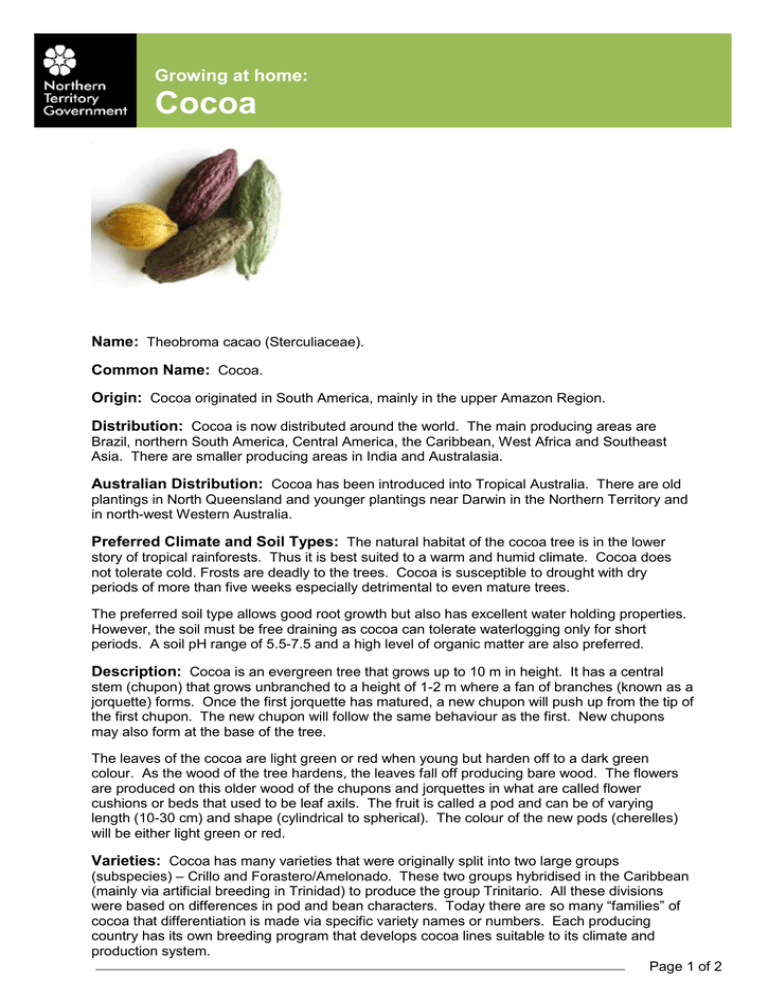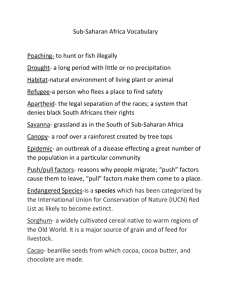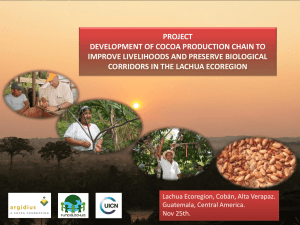Growing at home- Cocoa - Northern Territory Government
advertisement

Growing at home: Cocoa Name: Theobroma cacao (Sterculiaceae). Common Name: Cocoa. Origin: Cocoa originated in South America, mainly in the upper Amazon Region. Distribution: Cocoa is now distributed around the world. The main producing areas are Brazil, northern South America, Central America, the Caribbean, West Africa and Southeast Asia. There are smaller producing areas in India and Australasia. Australian Distribution: Cocoa has been introduced into Tropical Australia. There are old plantings in North Queensland and younger plantings near Darwin in the Northern Territory and in north-west Western Australia. Preferred Climate and Soil Types: The natural habitat of the cocoa tree is in the lower story of tropical rainforests. Thus it is best suited to a warm and humid climate. Cocoa does not tolerate cold. Frosts are deadly to the trees. Cocoa is susceptible to drought with dry periods of more than five weeks especially detrimental to even mature trees. The preferred soil type allows good root growth but also has excellent water holding properties. However, the soil must be free draining as cocoa can tolerate waterlogging only for short periods. A soil pH range of 5.5-7.5 and a high level of organic matter are also preferred. Description: Cocoa is an evergreen tree that grows up to 10 m in height. It has a central stem (chupon) that grows unbranched to a height of 1-2 m where a fan of branches (known as a jorquette) forms. Once the first jorquette has matured, a new chupon will push up from the tip of the first chupon. The new chupon will follow the same behaviour as the first. New chupons may also form at the base of the tree. The leaves of the cocoa are light green or red when young but harden off to a dark green colour. As the wood of the tree hardens, the leaves fall off producing bare wood. The flowers are produced on this older wood of the chupons and jorquettes in what are called flower cushions or beds that used to be leaf axils. The fruit is called a pod and can be of varying length (10-30 cm) and shape (cylindrical to spherical). The colour of the new pods (cherelles) will be either light green or red. Varieties: Cocoa has many varieties that were originally split into two large groups (subspecies) – Crillo and Forastero/Amelonado. These two groups hybridised in the Caribbean (mainly via artificial breeding in Trinidad) to produce the group Trinitario. All these divisions were based on differences in pod and bean characters. Today there are so many “families” of cocoa that differentiation is made via specific variety names or numbers. Each producing country has its own breeding program that develops cocoa lines suitable to its climate and production system. Page 1 of 2 Growing at home: Cocoa Culture: Cocoa originated in a warm and humid climate with plenty of shade. This environment must be approximately replicated when growing cocoa for profit. Cocoa can be planted directly as seed but better results are found by planting 6-month old seedling or grafted trees that have been in pots. The shade trees must have a strong stand when the cocoa plants are put into the ground. As the cocoa trees mature the shade trees will need to be removed in stages. The final level of shading necessary in Australian conditions has not yet been determined. Cocoa likes rich soils and as such lots of organic matter and fertiliser are necessary throughout the life of the tree. As cocoa trees are not drought tolerant, irrigation is required during drier periods. Cocoa trees need to be pruned to control growth and increase yields. Pruning consists of removing chupons, reducing height and clearing out the centres. Pests and Diseases: Cocoa has a number of very damaging diseases which are either endemic to the crop or are region specific. These include black pod rot and tree canker caused by Phytophthora fungi found around the world; witches broom caused by a fungus found in Central and South America; cocoa swollen shoot virus that is a major disease in West Africa; and vascular streak dieback is caused by a fungus found in Southeast Asia. There are management systems available to control these and other diseases but losses still occur. The major pests of cocoa include capsids, cocoa pod borer and mealy-bugs plus mammals and birds. There are successful management systems to control all these pests with both chemical and biological methods. Fruiting Season: Cocoa trees usually commence flowering 22 months from seed or 18 months from potted seedlings. However, first harvests do not usually occur until 18 months after planting. The time taken from flowering until pod maturity is temperature dependent but usually takes 4-6 months. Most mature cocoa plantings have near continuous harvesting with one major pick per year. There are management systems that reduce this continual flowering as competition between flowers and pods can reduce yields. Harvesting: Pod maturity is indicated by a change in colour (green to yellow; red to orange or crimson). The pods should be harvested just on colour change as mature pods often have germinated seeds within them, reducing bean quality. The pods have to be removed from the tree manually using a knife and are then thrown into the drive-lane for collection. The collected pods are split and the seeds are removed from the flesh inside. The seeds are then fermented and dried to produce cocoa bean suitable for further processing. Storage Conditions: Fresh seed (bean) does not store well. Pod splitting and fermentation should occur within a few days of harvest depending on plant variety. Once the beans have being fermented and dried they store well in a cool dry environment. Culinary Use: The bean can be processed to form cocoa butter, powder or liquor. The main use for all of these is in the manufacture of chocolate. Cocoa butter is also used in moisturising creams and soaps while cocoa powder is often used as chocolate flavouring. Plant Industries, Department of Primary Industry and Fisheries GPO Box 3000, Darwin NT 0801 [Normal] Telephone: 08 8999 2292 Facsimile: 08 8999 2049 Email: horticulture@nt.gov.au Web: www.horticulture.nt.gov.au Disclaimer: While all care has been taken to ensure that information contained in this information sheet is true and correct at the time of publication, the Northern Territory of Australia gives no warranty or assurance, and makes no representation as to the accuracy of any information or advice contained in this publication, or that it is suitable for your intended use. No serious, business or investment decisions should be made in reliance on this information without obtaining independent and/or professional advice in relation to your particular situation. Page 2 of 2





